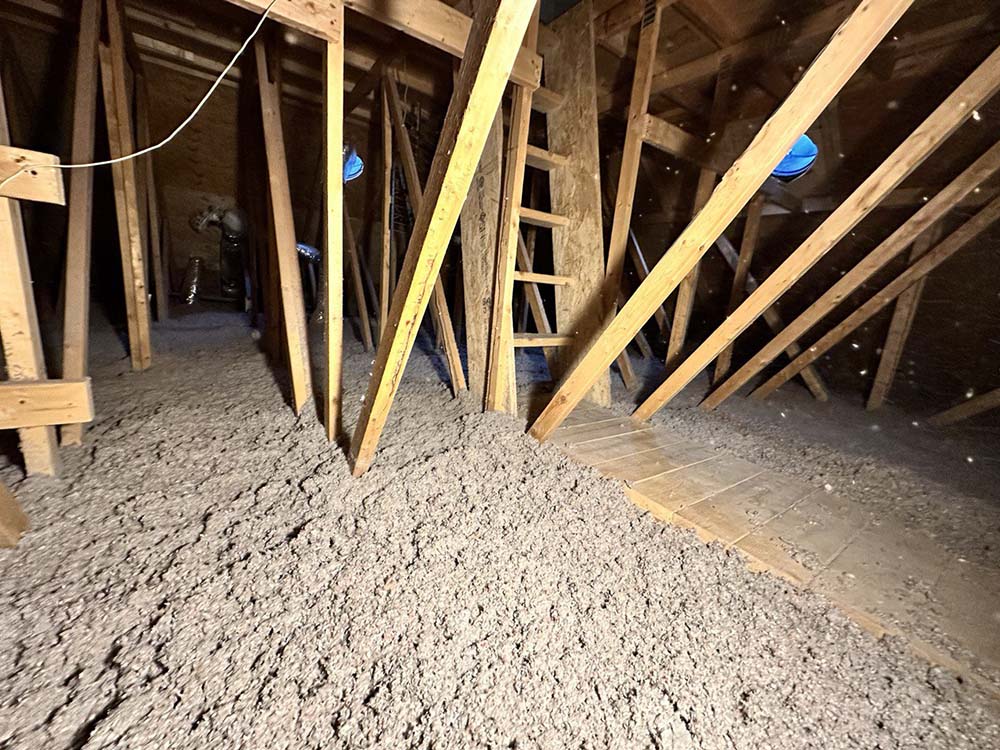Menu
Blown-in cellulose insulation is a type of insulation that’s made from recycled newspapers and other types of paper products. It’s treated with fire retardants and then blown into attics and walls using special equipment.

Cellulose blown-in insulation is a type of insulation material made from recycled paper fibers treated with fire-retardant chemicals. It is installed by blowing loose cellulose fibers into wall cavities, attics, or other spaces using special equipment. This insulation method creates a dense layer that helps to reduce heat transfer, increase energy efficiency, improve soundproofing, and enhance the overall comfort and thermal performance of buildings. Cellulose blown-in insulation is known for its eco-friendly properties and is often used as an alternative to traditional insulation materials.
Cellulose blown-in insulation offers several benefits for residential and commercial buildings:
Enhanced Energy Efficiency: Cellulose insulation has a high R-value, which means it provides excellent thermal resistance. It helps to reduce heat transfer, keeping the indoor space cooler in summer and warmer in winter. This leads to energy savings and reduced heating and cooling costs.
Excellent Soundproofing: Cellulose blown-in insulation’s dense fibers can help to reduce noise transmission between rooms and from outside sources, creating a quieter and more comfortable living or working environment.
Eco-Friendly Solution: Cellulose insulation is primarily made from recycled materials, such as shredded newspaper or cardboard. By choosing cellulose blown-in insulation, you are opting for an environmentally friendly option that helps reduce landfill waste and minimizes the need for new raw materials.
Fire Resistance: Cellulose insulation is treated with fire-retardant chemicals, making it highly resistant to flames. It can slow down the spread of fire and provide valuable time for evacuation or fire suppression.
Moisture Control: Cellulose insulation has the ability to absorb and release moisture, helping to regulate indoor humidity levels and prevent condensation issues. This can contribute to a healthier indoor environment by inhibiting the growth of mold and mildew.
Lorem ipsum dolor sit amet, consectetur adipiscing elit. Ut elit tellus, luctus nec ullamcorper mattis, pulvinar dapibus leo.
The Cellulose Blown-In Insulation process involves the following steps:
Inspection: Our team of experts will assess your property and identify areas that require insulation.
Preparation: The designated areas are prepared by ensuring proper ventilation and sealing any gaps or openings to maximize insulation effectiveness.
Material Preparation: The Cellulose insulation material is prepared by treating it with fire-retardant additives for safety.
Blowing Process: Using specialized equipment, the Cellulose insulation is blown into the designated areas such as attics, walls, or crawl spaces. The material fills the cavities and creates a seamless layer of insulation.
Distribution and Coverage: The blown-in insulation is distributed evenly, ensuring complete coverage and eliminating any gaps or voids.
Quality Check: Our team conducts a thorough inspection to ensure the insulation is properly installed and meets the desired standards of effectiveness and coverage.
By following this process, Cellulose Blown-In Insulation provides excellent thermal and sound insulation, enhances energy efficiency, and creates a more comfortable living environment.

Toronto Spray Foam and Insulation has over 5 years of experience in providing spray foam insulation solutions for residential and commercial properties.
94 Kenhar Dr, North York, ON M9L 1N2 Unit 42